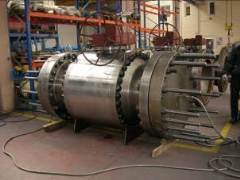Watch our Most Recent Videos | Visit us on LinkedIn | Visit us on YouTube
Valve Inspection
The Valve Inspection article provides you with information about the inspection of valves and valve testing in the manufacturing shop as well as in operational plants.You may review valve inspection procedure and valve ITP articles.
Valve Inspection - Shell Test

The valve inspections and testings are covered in I4I Academy courses. The I4I Academy API 570 Piping Inspector Course describes the in-service valve inspection and testing requirements, and the API Source Inspection Fixed Equipment Training course explains valve inspection and testing during manufacturing. API 570 covers that in API RP 574, and API Source Inspection covers that in API STD 598.
Valve Shell Test or Body test is performed after successful completion of valve individual components e.g. seat, disc, body, stem, etc. inspection and assembly. The test is conducted by valve manufacturer and based on the requirements of API STD 598 ( Valve Inspection and Testing).
The valve shall be partially open and be able to hold pressure for certain time. The pressure shall not be less than 1.5 times of maximum working pressure. No leakage is allowed.
Valve Inspection - Seat Leak Test
The Valve Seat Leak Test (Closure Test) is performed after successful completion of valve shell test (Body Test). One side (valve inlet or outlet) shall be subjected to the hydrostatic pressure and amount of leak shall be measured on the opposite side of the valve.
It means if you are pressurizing valve inlet, then you have to measure the amount of leakage in the outlet. The limited amount of leakage is permissible.
Valve Backseat Test
The Valve Backseat Test is performed in the valve with backseat feature. This is a feature that allows valve packing being replaced while it is in the service. In this test, valve shall be fully opened and packing gland shall be loose or not installed. No leakage is permissible in backseat test.
Pressure Safety Valve Inspection - Are you looking for information about pressure safety valves inspections during the manufacturing process? Or you are looking for in-service inspection in an operating plant?
The pressure safety valve is a direct, spring-loaded pressure-relief valve that is opened by the static pressure upstream of the valve and is characterized by a rapid opening or pop action.
When the static inlet pressure reaches the set pressure, it will increase the pressure upstream of the disk and overcome the spring force on the disk.
Fluid will then enter the huddling chamber, providing additional opening force.
This will cause the disk to lift and provide full opening at minimal overpressure.
The closing pressure will be less than the set pressure and will be reached after the blowdown phase is completed.
This article covers both shop and in-service inspection of the pressure safety valve.
Third Party Inspection for Valve - This content guides you through all the necessary stages in the production of the valves, from the examination of certification of procurement sources to the final inspection, preservation and packing, to the dispatch to site.
It is particularly suitable for the inspection of Gate, Globe, Ball and Check valves. The following points are addressed in this article:
- Valve Material Inspection
- Valve Welding Inspection
- Visual and Dimensional Checking
- Valve Low Pressure Air Test
- Valve Hydrostatic Testing
- Post Hydrostatic Testing
- Valve Final Inspection
- Valve Name Plate Checking
- Valve Painting and Coating Checking
- Valve Spare Parts, Loose Items and Accessories control
- Valve Packing, Marking and Shipping Inspection
Free newsletter!
Sign up to receive my monthly newsletter covering all the latest courses and updates.




New! Comments
Have your say about what you just read! Leave me a comment in the box below.